Scavenger predators
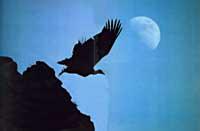
Although the Basque Country is small in size, and due to its geographical location, many different environments or habitats are observed, to which a great plant and fauna richness is associated.
It is true that human pressure, especially in the last century, has been enormous, with which numerous species have disappeared or are in serious danger of extinction, and others have suffered a significant setback, both in quantity and in extent.
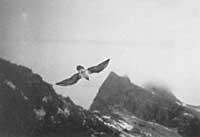
These include carrion birds of prey, which for thousands of years have been cleaning our forests and fields with waste, and which have suffered a huge setback in the last hundred years, mainly due to the fall of livestock and the "sanitary measures" of this new society. Three are the species that currently inhabit and reproduce in our mountains: Saiarrea ( Gyps fulvus), Saizuria ( Neophron percnopterus) and Quebrahuesos ( Gypaetus barbatus).
Saarre or vulture is the most abundant in Euskal Herria. Excellent bird that measures from the hillside to the slope 250-280 cm, with larger females, as in the rest of raptors. Being a skilful flyer, he takes advantage of wind currents to travel long distances with minimal effort and explore his territories repeatedly. Penetrating the thermal currents generated by the heat of the sun, it climbs from the loop to lose it and then descend it planning. Thanks to his sharp eyes, he can see dead animals from far away, and finding one concentrates incredible groups around him, being common to see their struggles.
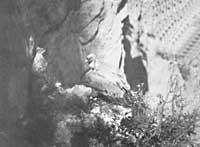
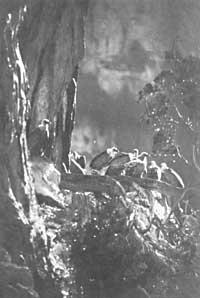
Against what has been believed locally, the vulture is a very scared and elusive animal, which never approaches the massacre without the certainty that there is never danger, and of course, would never dare to approach a living animal. All the information that says otherwise is a mere mythology.
The vulture zeal begins around December, when couples are formed and they begin to look for the ideal place to nest. Nests will be made in rocks and canyons, and if the space is adequate, large colonies are formed, which are permanent. The single-egg chitaje that will be installed in January or February has a duration of two months and is distributed between the male and the female. The Chito takes three months to lose the initial white plumage and get the adult brown feathers, and in this time parents should do a great job to complete their feeding. For this, both males and females, it combines the semi-liserite pieces of meat that has eaten in the vines, being devoured again immediately by the young man.
Sometimes we have seen gestures of struggle between the little boys and the parents, as we have seen in a nest in Navarre for catching some piece of meat that the young woman did not want to donate. From the third month, the kid spends a lot of time alone in the nest and his parents only bring him food once or twice a week. For the fourth month, the kid weighs more than 6 kg and is ready to fly.
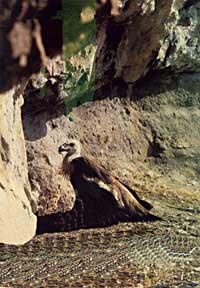
Saizuria is the second of the bushes mentioned. Attending to its ethology, this elegant black and white predator is really curious. This bird that invests in Africa has achieved a special fame for its ability to break the rock and eat its contents. On the other hand, the Saizuris are stable couples, returning every year from Africa to the same place, and if it has not deteriorated, every year they nest in the same place. The sexual behavior of these birds is also remarkable. It is not limited to Aralar, as they practice it all year. These striking behaviors also make known the pseudonym “alimoche”.
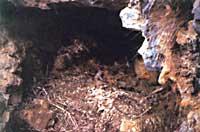
It is more daring than saizuri (which does not have as many food problems as this one) and is able to eat any pig in addition to the slaughter. In landfills it is frequent to find residues, at the same time that in the deyections of the animals has often been seen pecking, according to Novel, although it is probably believed that it is about looking for the large amount of Copris lunaris escáides that inhabit them. To say that it is a disgusting bird is to fall into a low anthropocentrism, but the really unsustainable is the smell of the slaughters that it has in the nest, especially in a warm summer environment.
This carroñero, of about 150 cm of cantilever, arrives at its place of flirting at the beginning of March, where highlights its striking white-black fins, white bodies, naked rocky areas and snout, both in flight and at rest. It nests in rocks, taking advantage of caves or cracks inapprehensible for predators. The materials of this work can be very different, and in a nest in Navarra there have been found remnants of fabrics and old "compresses", probably from some landfill.
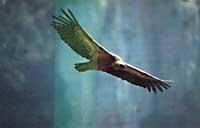
Although they usually lay two eggs, there will be a single little boy ahead, who will have to spend two and a half months in the nest. Then he has his pen complete. Feathers are dark, almost black, and until they reach sexual maturity (5-6 years) will not get black-white coloring of parents.
The bearded vulture is the last and most striking predator of Euskal Herria. This large demonic bird, with a 230-280 cm cantilever, has gathered around it numerous myths and histories. One of its races, besides its terrifying aspect, can be its special food. The main ingredient in their diet is the bones of dead animals, which eat them almost entirely.
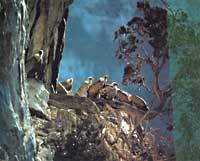
Back and black wings, with white feathers that give it marbled appearance. The pape and belly are white-reddish and on the head of the same color are black drawings and "moustaches" as antifas. If to this we add the red ring of the eyelid, to say that it has demonic appearance is understandable. In flight stands out its long dark snout tail.
Although the Basque Country was formerly very abundant, it has been practically exhausted in our mountains. Disappeared throughout Europe (except Greece and Kortsika), the last specimens live hidden in the Pyrenees, with a total of almost one hundred specimens (35 breeding pairs). Existing nests in the Basque Country can be counted on fingers.
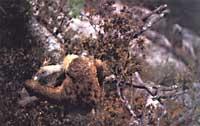
The bearded vulture is a high mountain bird that nests at heights of up to 2000 m. Incubation begins in February and lasts for two months. The kid will take four more months to leave the nest. Considering the harsh conditions of these heights and reservoirs, it is no wonder that only one of the two eggs placed can grow, and that too seriously.
As mentioned above, bones are the main component of the diet of the bearded vulture, although they do not despise meat. It completely devours the vertebrae, ribs and other small bones, which thanks to their specific secretions of their digestive tract can be assimilated. On the other hand, the larger bones catch them with the claw and take them to the air. Somewhere hidden from the mountain, loose from the height and break against the stones, eat cuajas and pieces.
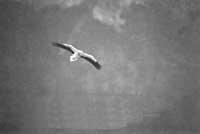
If we observe the customs or behaviors of these scavengers, we will define the hierarchy and distribution that occurs before a dead animal. As already mentioned, the saizuria is the most daring and the smallest, and this would be, along with the candles, the one that would fulfill the function of "pilot" to find the locks. When the saizuria reaches the haratustel begins to eat soft parts like the eyes, the tongue and the mouth, the anus... The adventurers who have flown until then, seeing that there is no danger, dare to approach little by little, until finally the saizuris have been abandoned.
These, with their powerful beak, will try to break the skin and look for the brooms of the deceased, a great invention for the long collado without feathers that allows them to freely access the plataneros. Once the vultures are saturated, only the larger bones and some pieces of leather remain, and the bearded vulture has to settle for it. And it is that the same white tailor, although smaller, would discard it if there remained some useful piece of meat. Therefore, the bearded vulture fulfills the last step of the trophic chain, using for its food bones that other scavengers cannot assimilate. It's not easy!
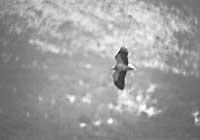
Unfortunately, as with other animals and plants, in the beginning it is mentioned that scavengers have also suffered a great setback. In the case of the saizuris, and for their adaptability, the problem is not so serious to comparison. In the case of tailors, however, there has been a major setback: R. According to estimates made by Elosegi, in Navarra 60 years ago there were 600 breeding pairs and in 1974 it calculated 282 couples (with a 10% error), while in Gipuzkoa and Bizkaia they have practically disappeared due to human pressure. In the case of the bearded vulture, as mentioned above, only about 100 specimens live throughout the Pyrenees, missing in central Europe and the Peninsula.
On the one hand, the decline in livestock and the "sanitary measures" of "civilized" society (including the burial and/or burning of locks) have accustomed food to scavengers. For his part R. Elosegi also mentions climate change and cooling as causes of decline. This is a hardening of reproductive conditions for these high mountain refugee birds. If this were not enough, there are many shotguns that circulate on the mountain and every year we have news of some barbarity. Finally, we must also mention the sneaky, poisons and "natural" garlic cloves, which are enriched at the expense of "lighters", collectors and zoos, as factors that threaten the survival of scavengers.
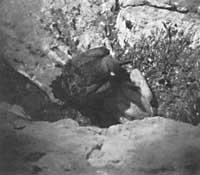
Finally, if in recent years this regression has been stopped and some uptick has been achieved, it must be said that it is due to the invaluable work of some ruined ornithologists. It is also necessary to take into account the implantation of the artificial feeders, although the suitability of the latter is controversial by the transformations that can produce in the behaviors of the scavengers.
Buletina
Bidali zure helbide elektronikoa eta jaso asteroko buletina zure sarrera-ontzian











